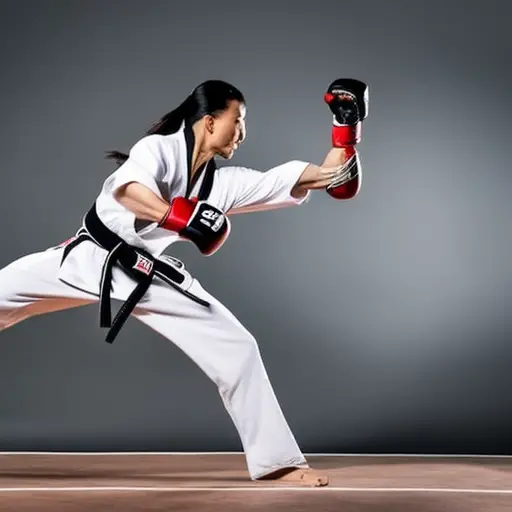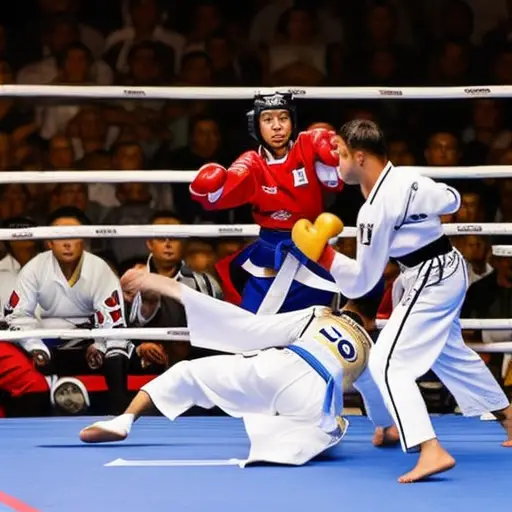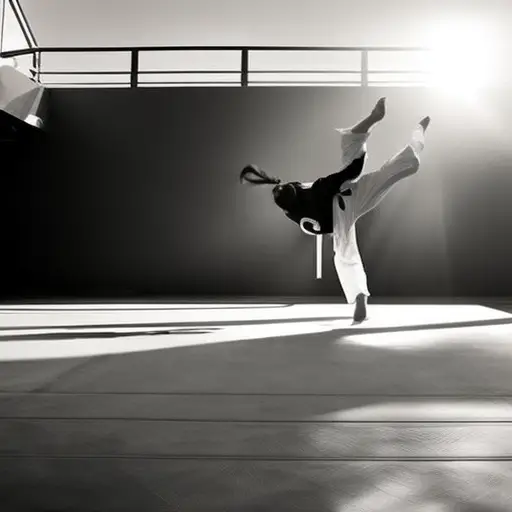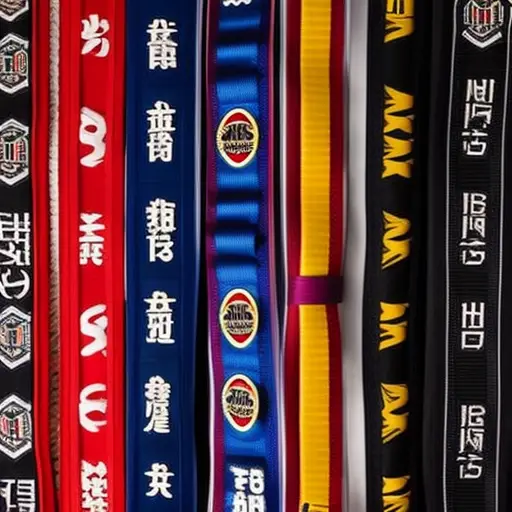Hand Techniques: Punches and Strikes in Taekwondo

While Taekwondo is renowned for its dynamic kicks and high-flying acrobatics, some may question the effectiveness of hand techniques in this martial art. However, it is important to recognize the power and precision behind punches and strikes in Taekwondo.
From the explosive cross and hook to the devastating palm strike and knifehand strike, this article delves into the technicalities and significance of these hand techniques.
Prepare to gain a deeper understanding of the lethal arsenal of Taekwondo punches and strikes.
Cross
The cross is a powerful and precise punch in Taekwondo, executed with a straight and horizontal motion of the arm across the body. It is one of the fundamental hand techniques used in this martial art, known for its effectiveness in both offensive and defensive situations.
The cross can be performed in various ways, offering practitioners the ability to adapt to different scenarios. Some cross variations include the straight cross, where the punch is thrown directly towards the target with maximum force, and the hook cross, where the punch is executed in a circular motion to generate additional power and create angles of attack. These variations allow practitioners to mix up their punches and keep opponents off balance.
Furthermore, the cross can also be used as a counter technique, known as the cross counter. This technique involves intercepting an opponent’s punch with a well-timed cross, striking simultaneously while avoiding the attack. The cross counter requires precise timing and accuracy, as it relies on the ability to predict and react quickly to an opponent’s movements.
When executing the cross, it is important to maintain proper form and technique. The arm should be fully extended, with the fist tightly clenched and the wrist locked to prevent injury. The power generated in the cross comes from the rotation of the hips and the transfer of weight from the rear foot to the front foot.
Hook
The hook is a fundamental hand technique in Taekwondo that requires proper technique, variations, and applications.
To execute a proper hook, the arm should be bent at a 90-degree angle, and the punch should be delivered with a rotating motion from the shoulder.
Hook variations include the lead hook and rear hook, which can be used to target different areas of an opponent’s body.
To develop strength and speed in the hook, practitioners can incorporate exercises such as shadowboxing, heavy bag training, and resistance training.
Proper Hook Technique
How does one execute the proper hook technique in Taekwondo? The hook is a powerful punch that is thrown in a semi-circular motion, targeting the opponent’s head or body.
To perform a proper hook technique, follow these steps:
- Start with a strong and balanced stance, with your feet shoulder-width apart.
- Keep your guard up, protecting your face and body.
- Rotate your hips and shoulders as you throw the punch, generating power from your core.
- Keep your elbow bent at a 90-degree angle, aiming to strike with the knuckles of your middle and index fingers.
- Pivot on your back foot and transfer your weight to add more force to the punch.
Common mistakes to avoid when executing a hook punch in Taekwondo include overextending the arm, dropping the guard, and failing to rotate the hips and shoulders effectively.
Hook Variations and Applications
As practitioners progress in their Taekwondo training, they can explore various hook variations and applications to enhance their striking techniques. The hook punch is a powerful and versatile strike that can be used in a variety of situations. It is commonly used in combination with other punches and kicks to create effective and dynamic combinations.
One important aspect of hook variations is the concept of hook counterattacks. This involves using the hook punch as a response to an opponent’s attack, effectively countering their movement and disrupting their balance. By practicing different hook counterattacks, practitioners can develop their timing, accuracy, and power in executing this technique.
In addition to hook counterattacks, it is crucial to learn and master hook defense techniques. These techniques involve evading or blocking an opponent’s hook punch to avoid getting hit. Proper footwork, head movement, and defensive positioning are essential in effectively defending against hook punches.
To illustrate the various hook variations and applications, the following table provides a summary:
| Hook Variation | Description | Application |
|---|---|---|
| Overhand Hook | A looping hook punch thrown from above | Used to attack an opponent’s temple or jawline |
| Uppercut Hook | A hook punch thrown in an upward motion | Effective in targeting an opponent’s chin or solar plexus |
| Lead Hook | A hook punch thrown with the lead hand | Often used to set up combinations or counterattacks |
Strength and Speed Training
Developing both strength and speed are essential for effective execution of the hook punch in Taekwondo. To enhance these attributes, practitioners can engage in specific strength and speed training exercises. Incorporating agility training into their routine can improve footwork and quickness, allowing for better setup and delivery of the hook punch. Power development is another important aspect to focus on, as it ensures that the punch carries enough force to effectively strike the target.
Here are five key exercises for strength and speed training in Taekwondo:
- Medicine ball rotational throws: Enhances rotational power and core strength.
- Plyometric push-ups: Improves upper body explosiveness and speed.
- Resistance band punches: Increases punching speed and shoulder strength.
- Speed ladder drills: Enhances footwork, agility, and coordination.
- Medicine ball slams: Develops overall power and explosiveness.
Uppercut
An uppercut is a powerful punch that can be utilized in Taekwondo to deliver significant impact to an opponent. The uppercut technique involves a vertical punch that is aimed towards the chin or body of the opponent. This punch is delivered by rotating the torso and generating power from the legs and hips.
There are several variations of the uppercut that can be used in Taekwondo. The first variation is the lead uppercut, which is thrown with the leading hand. This punch is quick and can catch the opponent off guard. The rear uppercut, on the other hand, is thrown with the rear hand and is generally more powerful. It is commonly used to counter an opponent’s attack.
Another variation is the shovel hook uppercut, which combines the uppercut and hook techniques. This punch is thrown in a circular motion, starting low and sweeping upward towards the target. It is effective in close-range combat and can cause significant damage.
The uppercut is a versatile punch that can be used in various situations in Taekwondo. It is important for practitioners to master the proper technique and understand the different variations to effectively incorporate it into their fighting strategy.
Palm Strike
The palm strike is a highly effective hand technique used in Taekwondo, capable of inflicting significant damage to an opponent. It can be delivered to various target areas, including the nose, chin, throat, and solar plexus, with the intention of stunning or incapacitating the opponent.
Additionally, there are different variations of the palm strike, such as the vertical palm strike and the knife-hand palm strike, each with its own specific application and potential impact.
Effective Palm Strike
The palm strike is a potent hand technique in Taekwondo, known for its effectiveness in close-range combat. This technique involves striking with the palm of the hand, using the heel of the palm or the base of the fingers as the point of contact. The palm strike is an excellent alternative to a punch, as it allows for a wider striking surface and reduces the risk of injuring the hand.
Here are five key points to consider when using the palm strike technique:
- Proper stance and body alignment are crucial for generating maximum power and stability.
- Aim for vital targets such as the nose, chin, or solar plexus to incapacitate your opponent.
- Utilize the whole body, transferring power from the legs, hips, and core into the strike.
- Practice precision and accuracy to ensure effective strikes.
- Develop hand and wrist strength to enhance the power behind your palm strikes.
Mastering the palm strike technique and refining its power can greatly enhance your close-range combat skills in Taekwondo.
Target Areas for Strikes
Striking with a palm strike offers various target areas to effectively immobilize an opponent, such as the nose, chin, and solar plexus. By targeting these specific areas, a taekwondo practitioner can deliver powerful strikes that can incapacitate an opponent. Developing power in palm strikes requires proper technique and conditioning. It is essential to generate power from the legs and hips, transferring the energy through the arm and into the palm strike. Common mistakes in targeting include incorrect alignment and improper distance. It is crucial to aim accurately and make sure the strike lands on the intended target. The following table illustrates the target areas for palm strikes in taekwondo:
| Target Area | Description | Effect |
|---|---|---|
| Nose | Striking the bridge of the nose can cause pain, disorientation, and potential injury to the nasal bone. | Can disrupt breathing and impair vision. |
| Chin | A palm strike to the chin can cause the head to snap back, potentially leading to a knockout. | Can cause dizziness and loss of balance. |
| Solar Plexus | Striking the solar plexus can cause intense pain and temporarily immobilize the opponent. | Can cause a loss of breath and disrupt the opponent’s focus and movement. |
Palm Strike Variations
Palm strike variations in taekwondo encompass a range of techniques that utilize the palm of the hand as a powerful striking tool. These techniques are not only effective for self-defense but also improve overall striking ability.
To enhance palm strike techniques and maximize their impact, specific training methods can be employed. Some common palm strike variations and training approaches include:
-
Straight Palm Strike: This technique involves striking the target with the palm facing forward, using the base of the hand.
-
Knife Hand Palm Strike: In this variation, the palm strike is executed with the hand shaped like a knife, with the fingers extended and held tightly together.
-
Ridge Hand Palm Strike: This technique utilizes the outer edge of the hand, striking with the ridge formed by the thumb side of the palm.
-
Hammer Fist Palm Strike: The palm strike is executed with a clenched fist, using the bottom of the palm or the base of the hand to strike.
-
Wing Chun Palm Strike: This technique involves striking with a slightly cupped hand, using the center of the palm as the striking surface.
To improve palm strike training, practitioners can focus on developing proper body mechanics, targeting specific areas of the body, and practicing striking with speed and precision. By incorporating these techniques and training methods into their practice, taekwondo practitioners can enhance their striking abilities and become more versatile in combat situations.
Knifehand Strike
One of the most effective hand techniques in Taekwondo is the knifehand strike. This technique involves striking with the side of the hand, using the edge formed by the base of the small finger and the wrist. The knifehand strike is a versatile technique that can be used in various applications, both offensive and defensive.
In terms of applications, the knifehand strike can target vulnerable areas such as the neck, temple, or collarbone, delivering a powerful and precise blow. It can also be used to strike pressure points, effectively immobilizing an opponent or causing intense pain. Additionally, the knifehand strike can be used to block or parry incoming attacks, redirecting the opponent’s force and creating an opportunity for counterattacks.
There are different variations of the knifehand strike that can be employed depending on the situation. These variations include the downward, upward, and horizontal knifehand strikes. Each variation has its own advantages and can be used effectively in different scenarios.
Transitioning into the subsequent section about the hammerfist strike, it is another important hand technique in Taekwondo. While the knifehand strike focuses on precision and targeting specific areas, the hammerfist strike emphasizes power and brute force.
Hammerfist Strike
When executing the hammerfist strike in Taekwondo, practitioners utilize the base of their closed fist, employing a downward or sideways motion to deliver a forceful blow. The hammerfist strike is a versatile technique that can be used in various situations. Here are some applications and advantages of the hammerfist strike:
-
Self-defense: The hammerfist strike is effective in close-quarters combat, allowing practitioners to strike with force and precision. It can be used to target vulnerable areas such as the nose, jaw, or temple, causing significant impact and potentially incapacitating an opponent.
-
Breaking techniques: The hammerfist strike is commonly used in breaking techniques, where practitioners aim to break boards, bricks, or other objects. Its downward or sideways motion generates a powerful force, making it an ideal technique for breaking demonstrations.
-
Close-range strikes: Unlike punches or kicks, the hammerfist strike can be executed from close quarters, making it useful in grappling situations. It can be employed to strike an opponent while in a clinch or to create distance and escape from an attacker.
-
Non-lethal force: The hammerfist strike can be delivered with varying degrees of force, allowing practitioners to control the level of impact. This makes it a suitable technique for situations where non-lethal force is required, such as restraining an attacker or diffusing a confrontation.
-
Versatility: The hammerfist strike can be adapted to different angles and directions, depending on the target and the situation. This versatility makes it a valuable technique in Taekwondo, allowing practitioners to adjust their strikes based on the specific circumstances they face.
Backfist Strike
Moreover, the backfist strike is a highly effective and versatile technique in Taekwondo, offering practitioners a unique and powerful way to strike their opponents. This strike involves striking with the back of the closed fist, using the knuckles of the middle and index fingers. It is commonly used to target the head and face of an opponent.
There are several variations of the backfist strike in Taekwondo. One variation is the straight backfist, where the arm is extended straight out from the body and the strike is delivered in a linear motion towards the target. Another variation is the spinning backfist, where the practitioner rotates their body and delivers the strike with the back of their fist.
To effectively execute the backfist strike, practitioners must focus on developing proper technique and speed. Training drills for the backfist strike include shadow boxing, where practitioners practice the strike in the air, focusing on proper form and technique. They can also use focus pads or heavy bags to practice striking with power and accuracy.
Frequently Asked Questions
How Do I Improve the Power and Speed of My Punches in Taekwondo?
To improve the power and speed of punches in Taekwondo, it is essential to focus on proper technique. Generating maximum power and speed involves utilizing correct body mechanics, incorporating hip rotation, and optimizing the role of footwork for enhanced effectiveness.
Are There Any Specific Hand Conditioning Exercises to Strengthen the Striking Techniques?
There are several hand conditioning exercises that can be used to strengthen striking techniques in Taekwondo. These exercises focus on improving power and speed, and can include wrist curls, finger push-ups, and striking a heavy bag.
Can I Use Punches and Strikes in Taekwondo for Self-Defense Purposes?
Punches and strikes in Taekwondo can be effective for self-defense purposes. While Taekwondo is known for its emphasis on kicks, its punching techniques, including straight punches and uppercuts, can deliver powerful blows. Additionally, Taekwondo practitioners are trained in blocking and evasive maneuvers to defend against punches and strikes.
Are There Any Specific Rules or Regulations Regarding the Use of Punches and Strikes in Taekwondo Competitions?
There are specific rules and regulations governing the use of punches and strikes in taekwondo competitions. These guidelines ensure fair and safe competition while showcasing the effectiveness and precision of practitioners’ striking techniques.
How Can I Effectively Combine Punches and Strikes With Kicks in Taekwondo Sparring?
Combining punches and kicks in taekwondo sparring requires strategic planning and coordination. Effective striking and kicking combinations can be achieved by utilizing proper footwork, timing, and targeting specific areas of the opponent’s body.
Conclusion
In conclusion, the various hand techniques employed in taekwondo, such as the cross, hook, uppercut, palm strike, knifehand strike, hammerfist strike, and backfist strike, offer practitioners a range of effective strikes for both offensive and defensive purposes.
By mastering these techniques, taekwondo practitioners can enhance their fighting skills and improve their overall performance in combat situations.
So, why not delve deeper into the world of taekwondo hand techniques and discover the power they hold in unleashing one’s potential?





